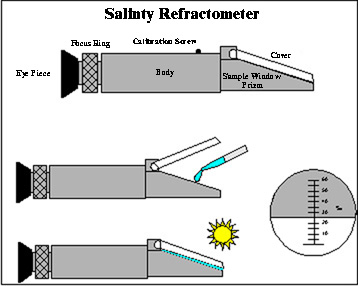SALINITY
The Bayouside Classroom program uses two methods for measuring salinity. They consist of using a refractometer or using a hydrometer. The directions for using a refractometer are below. If you are using a hydrometer, you can find the directions here.
USING A REFRACTOMETER
A refractometer takes advantage of the fact that light bends as it passes through different materials. In water, the amount of bending (refraction) is related to how much salt is dissolved in the water. The refractometer gets its name from the refractive index, which is a measure of how far light is bent by different materials. For example, at 20ºC, the refractive index of pure water is 1.333, while the refractive index of seawater (salinity = 35 ppt) is 1.339.
When using a refractometer, a sample is placed on an optical prism in the sample window. As light shines through the sample, it is bent according to the salinity of the water and casts a shadow on the scale that is visible through the eyepiece. Salinity is read directly through the eyepiece. 
Prior to using the refractometer it should be checked to make sure that it is reading properly. It should be calibrated if it is not. First open the coverplate and clean the prism with a soft cloth to avoid scratching the surface of the prism. Next place several drops of distilled water on the prism and close the cover plate. If the refractometer reads zero, then it is working properly and no further steps are needed. If the refractometer reads anything other than zero, remove the rubber cap on the calibration screw. Rotate the calibration screw so that the dark and light boundary line is at exactly “0” on the ppt scale. Replace the rubber cap and the refractometer is ready for use.
- Using water from the collected sample, rinse the eyedropper or disposable pipette by filling and emptying 3 to 4 times. Similarly rinse the optical prism on the refractometer using water from the sample.
- Once both the pipette and prism are rinsed, fill the pipette with water from your sample. Holding the refractometer level, place several drops of sample on the prism. Make sure the water does not run off the prism.
- Close sample cover, removing all air bubbles.
- Hold refractometer upright in the direction of a strong light source (e.g. the sun).
- Turn the focus ring until the scale is clearly visible.
- Read salinity in parts per thousand (ppt, the right side of the scale) at the intersection of the light and dark fields in the eyepiece.
- Record the result on the data sheet.
- Rinse the sample window with fresh water three times, and gently wipe sample window with soft tissue or lens paper.
|
Important steps to remember:
|
